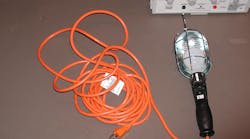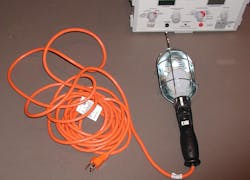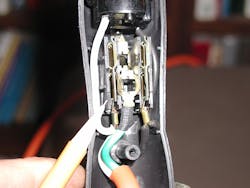When a Virginia man realized his pregnant wife was spending more than her usual amount of time in the shower one September 2003 evening, he decided to see what was taking so long. His concern rose to panic when he entered the bathroom to look in on her. As the water continued to run and fill the shower pan, his wife sat unconscious and slumped over in the corner of the shower stall. She was unresponsive, and the husband's attempts to revive her were ultimately unsuccessful.
The woman's body showed no sign of trauma, but the possible cause of her death soon became apparent. Immersed in water next to her, the husband noticed the 120VAC portable hand lamp he had hung on a hook in the shower stall to provide light while he finished a home improvement project that involved installing a ceiling light fixture overhead (Photo 1). The hand lamp was plugged into a GFCI-protected bathroom receptacle via its attached 25-foot power cord, which was draped over the shower stall door.
At first the woman's death appeared to be no more than the result of a series of unfortunate events, but seemingly contradictory facts uncovered in the initial investigation began to raise questions about why the GFCI didn't prevent the electrocution and whether the husband had anything to do with the death.
Assessing the scene
The fact that the husband had drastically altered the scene in his efforts to assist his wife before police and medical personnel arrived made it difficult for the investigative team to piece together exactly what had happened or determine the order of events. The lamp appliance switch was in the “ON” position and the GFCI that supplied it had tripped, both of which suggested that the lamp was energized at the time of the incident. If the GFCI had tripped, though, how had the woman been electrocuted? And it was obvious that the lamp fell, but at what point and how?
The woman's body had blocked the shower drain, causing it to fill up, but there was no way to know when. Did she receive a lethal shock from the lamp itself and then fall and block the drain, or did she collapse for reasons unrelated to the appliance, only to be electrocuted when the lamp fell into the pool of water that accumulated when she blocked the drain?
Because of the suspicious nature of the death and the fact that the police were considering the husband a suspect, they retained me to evaluate the case. Using the actual lamp found at the scene and a replica of the shower, I conducted a battery of tests to better understand how she was electrocuted.
Testing and analysis
The governing UL standard, UL 298, Safety for Portable Electric Hand Lamps, requires a hand lamp like the one found in the shower to withstand 1,250V for one minute in a dielectric voltage withstand test, but the sample lamp broke down in five seconds at only 400V.
After disassembling the lamp, I made clearance measurements between components and found why the lamp failed the test so quickly. The spacing between the integral receptacle's grounding lug and neutral attachment was less than 0.04-inch, significantly less than the 0.25-inch specified in UL 298 (Photo 2). To make matters worse, the grounding lug for the receptacle could move and rotate to some degree, serving to further reduce the spacing. Inspection proved the deficiency was a design defect rather than a condition caused by deterioration or use of the appliance.
In addition, a missing screw allowed for a slight separation between the two halves of the upper part of the handle, exposing the internal components to dust, dirt, debris, water, and water vapor.
Non-compliance with the leakage criteria quickly surfaced as the primary critical factor in this incident. In order to evaluate leakage current, I energized the lamp at 120VAC and monitored the resulting current flow to the lamp's grounding tab.
High ambient humidity, which would be found in a steamy bathroom like the one in question, affects ground leakage performance since water vapor can collect or condense on energized electric components and parts, which generally causes increased leakage current between inadequately spaced electrical connections or components.
In a dry state, tests found the ground leakage current of the lamp to be 25 µA, which is an acceptable value. However, when the appliance was subjected to a humid environment of 90∞F at 85% relative humidity for one-half hour — far less than the 88% relative humidity for 48 hours as specified by UL Standard 101 (incorporated by reference in UL 298) — leakage current measurements indicated the grounding circuit to be directly connected to one side of the AC line. In fact, even 40% to 50% humidity would have been enough to increase the leakage current to lethal levels.
I also tested for electric shock risk for an individual partially immersed in water with the 120VAC energized appliance immersed and in relative close proximity to the individual. With about 1 inch of water in the replica shower and with the appliance's guard in loose contact with its grounding tab, 125mA was recorded, and at 2 inches of depth, current quickly increased to about 500mA. I stopped the tests at 3 inches of depth, when current reached nearly 4,000mA. The deficient leakage performance discussed earlier confirms the high likelihood for electric shock injury to individuals coming into contact with either the appliance's metallic guard or grounding strip.
Additional tests showed with a reasonable degree of engineering certainty that although the lamp was hanging in a precarious position, the way in which the power cord was draped over the shower door would have prevented the lamp from falling into the shower pan without human intervention to either add tension or modify the tension angle enough to overcome frictional forces affecting the cord.
Conclusions
No one will ever know exactly what happened to precipitate the electrocution, but the results of the tests make it possible to offer a likely scenario. The woman's size at the time of the accident (5 feet, 2 inches tall and 220 pounds) and the relatively small size of the shower make it likely that in the course of showering she bumped the light and knocked it from its hook. The humidity in the shower would have caused water to condense in the lamp and bridge the already small gap between the grounding lug and the neutral, energizing the metallic lamp guard. Whether she caught it as it fell or tried to replace it after it did, the resultant leakage current she would have been exposed to when grasping the lamp was more than enough to send her heart into ventricular fibrillation. As she collapsed, she pulled the light with her to the floor of the shower, where it was eventually submerged as the water level rose. It wasn't until this point that the GFCI finally tripped.
Because of the likelihood that proper and timely operation of the GFCI device may have been hindered by the proximity of the grounding tab and the neutral attachment, it was likely that anyone in a running shower with the inappropriately located and defective appliance would be at a considerable risk of electric shock injury or electrocution.
The investigation showed that the electrocution was most likely an accident, and the husband was spared from criminal prosecution. However, he wasn't completely relieved of responsibility. Not only did he fail to secure a permit for the work in his shower or have it inspected, thereby violating state and local laws, he had no formal training in electrical system construction. Although he wasn't directly involved with the electrocution, his disregard for electrical safety and proper installation rules no doubt played an indirect role in his wife's death.
Ruggieri, P.E., is a forensic engineer with General Machine Corp. in Washington, D.C.





